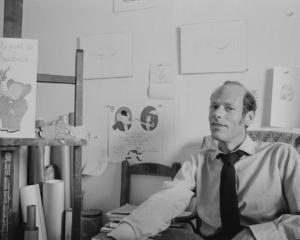
The only equation Stephen Hawking included in A Brief History of Time was Einstein's famous E=mc2, saying, perhaps a little tongue in cheek, he had been told every equation would halve sales.
Hawking's PhD student at Cambridge, Christophe Galfard, has taken the great master's advice.
Therein lies the author's difficulty, because the great mysteries of space, time and relativity virtually defy words and exist only in equations.
A century-old story relates how physicist Sir Arthur Eddington replied to the compliment that only three people truly understood Einstein's general relativity by saying hesitantly he was trying to think of the third person!
Galfard asks you to dream thought-experiments in the agreeable environment of a tropical island.
He takes you to the centre of the sun to watch how atomic nuclei fuse together at 16 million degrees Celsius, releasing a little mass as the energy that ultimately bathes the Earth.
He takes you progressively to the edge of the visible universe, if there is one.
Sir Isaac Newton derived a simple theory of motion and gravity that predicted the movements of the planets around the sun with almost perfect accuracy, except for a tiny but persistent error with Mercury.
So precise are astronomical measurements, that being almost correct is not an option.
Nobody realised until the early 20th century, and the discovery of general relativity, why Newton's theory was imperfect.
The reason it works for all intents and purposes is that the discrepancy is too small to measure unless colossal speeds or massive gravity are involved, but with Mercury being close to the sun, that unknown correction was fatal.
The greatest trap in science is a theory that works for the wrong reason.
When that happens, our cosy explanation of nature is completely wrong because it is constructed on the wrong principles.
Newton's basic assumptions of absolute space and time were obvious, surely?
Assuredly not, because the other nasty trap awaiting all scientists is the supposedly obvious, and the notion had to be discarded.
Einstein's theory of space-time works at all velocities up to that of light, which Newton's certainly doesn't.
In a journey through time and space, we can see into the past, which seems rather clever.
The penalty is, we can see only the past. We see even our friends in the past because light takes a finite time to cross a room.
If the sun went out, we would be blissfully unaware for the eight minutes its light takes to reach us.
At the other extreme, distant galaxies are seen as they were up to 13.8 billion years ago and may be long gone (which makes sending them messages rather futile).
You will love this book if you enjoy mental contortions.
What is the difference between galaxies moving away from us and space itself expanding?
If our view of distant space is 13.8 billion years out of date, what's out there now?
Why does travelling at 87% of light speed cause you to age at half the rate of your Earth-bound twin?
The last calculation is so simple it would not have been amiss, but the author has stuck to his determination to manage without.
His uniquely gripping style spans from infinities of space and time to the quirky unrealities of quantum behaviour, black holes, strings and wormholes.
In putting these into words alone he has striven for the impossible, which notoriously takes a little longer, so this is a good long read.
• Clive Trotman is a Dunedin scientist and arbitrator.











